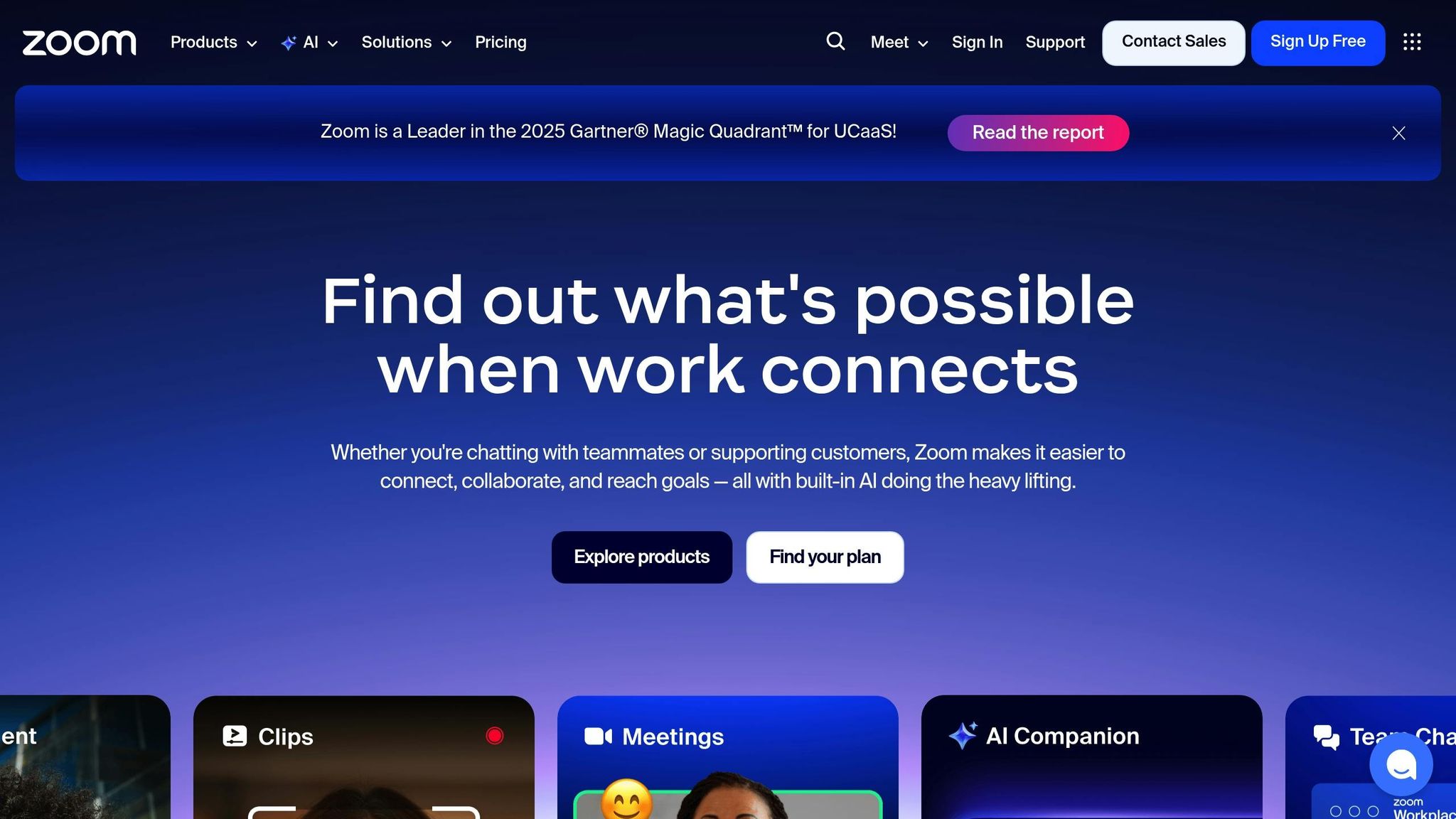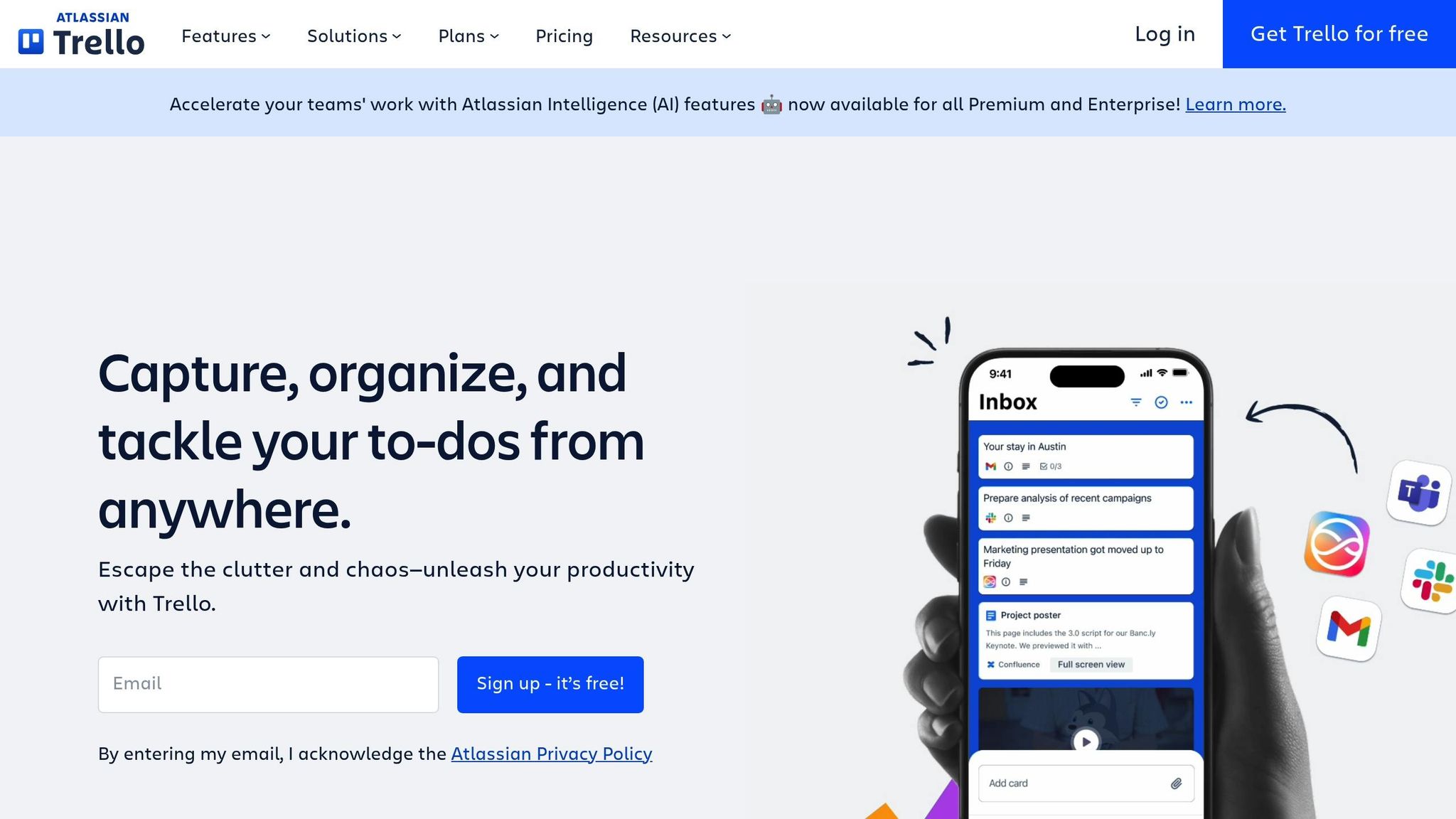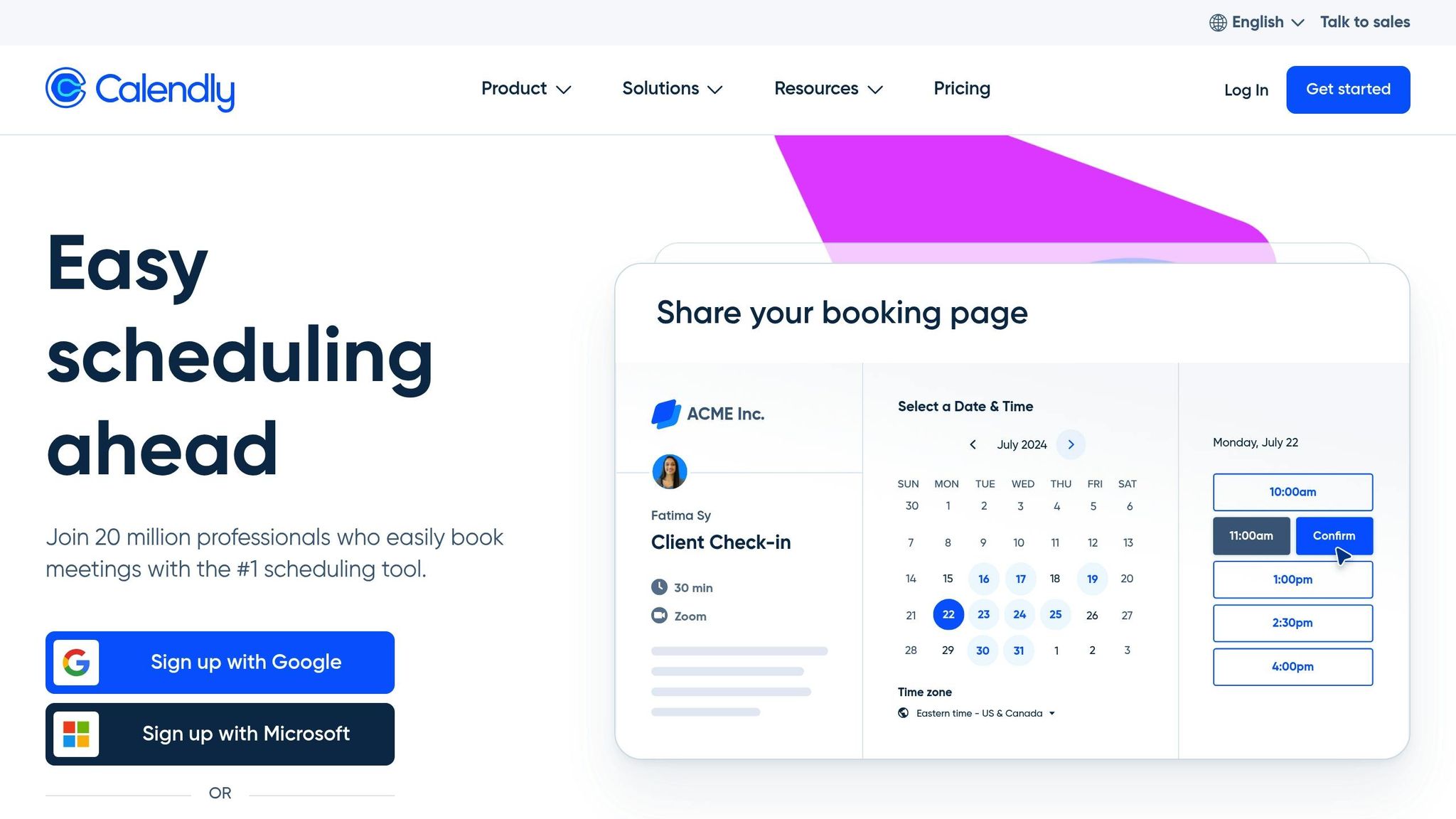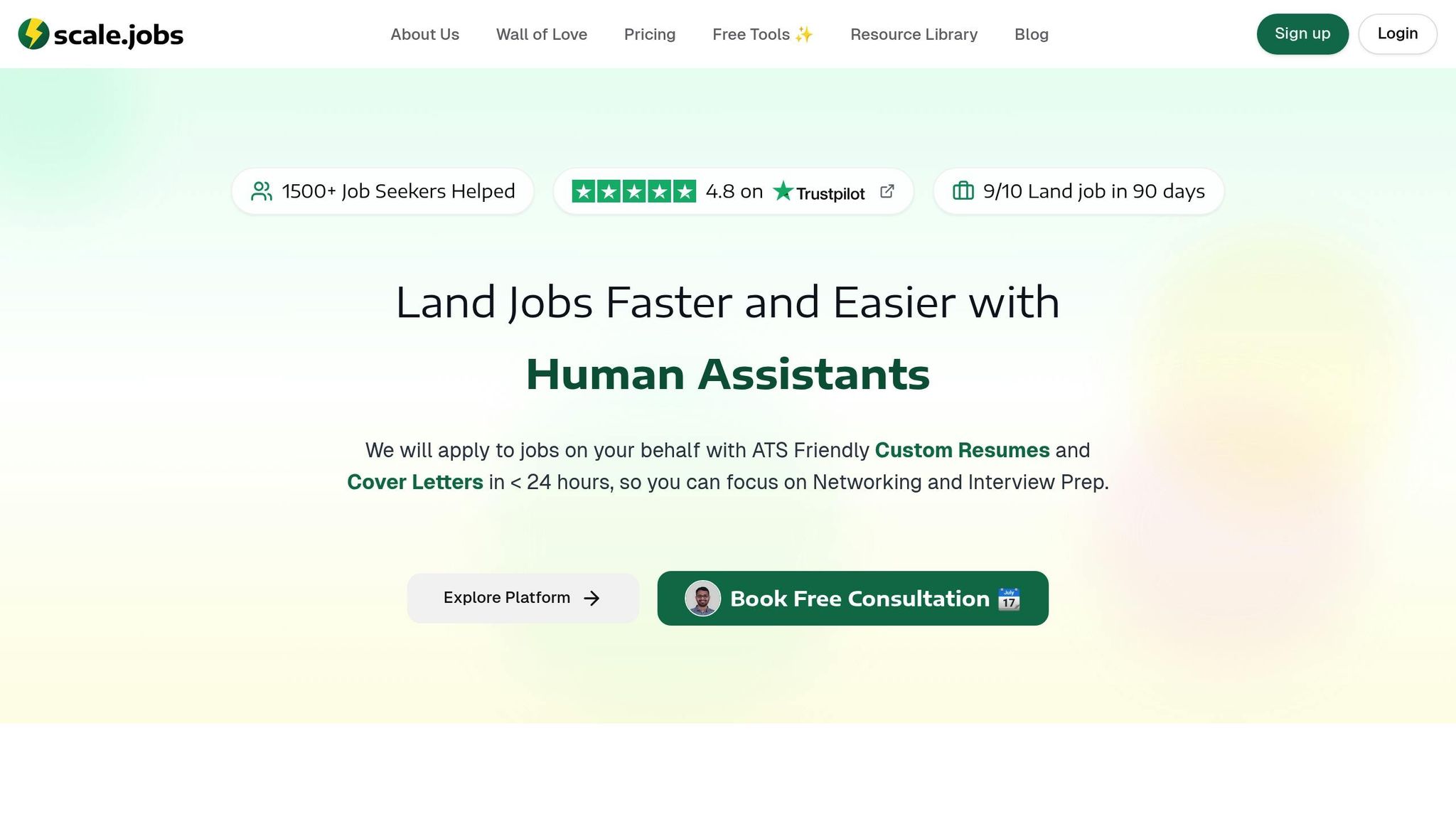Ultimate Guide to Virtual Collaboration Tools for Job Seekers
scale.jobs
October 3, 2025
Mastering virtual collaboration tools is now a must for job seekers. With remote and hybrid work becoming the norm, employers expect candidates to be skilled in tools like Zoom, Microsoft Teams, and Trello. These platforms are essential for interviews, networking, and managing job applications efficiently.
Here’s what you’ll learn:
- Communication Tools: Use Zoom, Teams, and Slack for interviews, team discussions, and professional networking.
- Organization Tools: Platforms like Trello and Asana help you track applications and manage tasks.
- Scheduling Tools: Calendly and Doodle simplify booking interviews and meetings.
- Advanced Features: Learn screen sharing, breakout rooms, and automation tools like Zapier to save time and boost productivity.
- Privacy & Security: Protect your data with VPNs, password managers, and secure file-sharing practices.
Why it matters: Employers value candidates who can navigate these tools confidently. This guide breaks down how to use them effectively and stand out in the job market.
Core Virtual Collaboration Tools for Job Seekers
Communication Tools: Zoom, Microsoft Teams, and Slack

Zoom has become the go-to platform for virtual interviews and networking. Recruiters often expect you to be familiar with its basic functions, like muting/unmuting, screen sharing, and using the chat feature. To stand out, learn how to use its virtual background feature, which can help maintain a polished appearance even if your home workspace isn’t ideal. Be prepared for the waiting room feature, commonly used to manage interview start times.
Microsoft Teams is a must-know tool for those aiming for roles in industries like finance, healthcare, or enterprise tech. Its integration with Office 365 makes it great for document collaboration, which is often part of corporate hiring processes. You might encounter tasks like real-time case study reviews or collaborative presentations during interviews. Key features to get comfortable with include file sharing within chats, using @mentions for direct communication, and joining meetings directly from your browser without needing to install the app.
Slack is widely used in startups and tech companies for day-to-day communication. Some companies even use Slack for informal interviews or to coordinate with candidates during the hiring process. Understanding Slack etiquette can make a big difference - use threads for follow-ups, acknowledge messages with emoji reactions, and keep your status updated. Occasionally, companies may invite you to a Slack workspace during the hiring process to evaluate your communication skills.
Each platform serves a unique purpose. Zoom is ideal for formal video calls and large meetings, Teams excels in document-heavy collaboration, and Slack is perfect for ongoing team communication and quick updates.
Once your communication tools are in place, staying organized is the next step.
Organization Tools: Trello, Asana, and Google Workspace

Trello uses a simple card-based system that's great for visually managing your job applications. You can create boards to represent different stages of your search, such as "Applied", "Phone Screen", and "Interview Scheduled." Each application can be a card where you track details like deadlines, job descriptions, and research notes.
Asana offers a more detailed approach to project management, which can also demonstrate your organizational skills to potential employers. You can create separate projects for tasks like networking, skill-building, and interview prep. With its timeline view, you can map out your job search over weeks or months. Asana's reporting tools are especially useful for tracking metrics like your application-to-interview ratio, which can highlight your analytical mindset to employers who value data-driven thinking.
Google Workspace (formerly G Suite) is essential for collaborative tasks during your job search. Use Google Docs for real-time editing of cover letters with mentors or career advisors. Google Sheets can serve as your job tracking hub, complete with formulas to calculate response rates or time-to-hire statistics. And with Google Drive, all your materials - from resumes to reference letters - are accessible from any device and easily shareable.
Using these tools effectively not only keeps your job search on track but also shows employers that you’re capable of managing complex projects efficiently.
With communication and organization handled, scheduling tools can help you further streamline your efforts.
Scheduling Tools: Calendly and Doodle

Scheduling tools eliminate the back-and-forth emails that often come with coordinating interviews, while also showcasing a professional edge.
Calendly simplifies the process of scheduling interviews, making it easier for busy recruiters to find time with you. You can set up different meeting types, such as 30-minute phone screens, 60-minute technical interviews, or 45-minute final rounds. Add buffer times between meetings to avoid feeling rushed. Including your Calendly link in your email signature or LinkedIn profile makes it easy for recruiters to book a time that works for both parties. For international job seekers, Calendly is especially helpful for managing time zone differences without unnecessary delays.
Doodle is better suited for group scheduling, such as panel interviews or networking events with multiple participants. If a company needs to coordinate a final round interview with several team members, Doodle polls can quickly identify a time that works for everyone. This tool is particularly useful for smaller companies or startups that might not have advanced scheduling systems.
Both Calendly and Doodle integrate seamlessly with major calendar platforms like Google Calendar and Outlook, ensuring your schedule stays synced across devices. A well-organized, professional scheduling setup can leave a lasting impression on employers and set you apart from candidates who rely on lengthy email chains to coordinate meeting times.
Advanced Features and Strategies for Virtual Collaboration
Using Screen Sharing and Breakout Rooms
Screen sharing is a must-know skill for job seekers, particularly during technical interviews or portfolio presentations. Start with the basics: learn how to share either your entire screen or a single application window. Avoid common pitfalls like accidentally displaying personal files or cluttered desktops - it’s not a good look. Practice switching between apps smoothly, and close any unnecessary programs ahead of time.
For live coding interviews, preparation is key. Test your setup beforehand, and make sure your code editor uses a font size that’s easy to read (at least 14pt). Some companies prefer collaborative platforms like CodePen or Replit for these sessions, so get comfortable with sharing browser-based tools if needed.
When presenting your portfolio, organization is everything. Create a dedicated folder on your desktop with all your materials ready to go. Practice navigating between projects seamlessly so you don’t waste time or appear unprepared. If you’re a designer, ensure your work is saved in high-resolution formats that look sharp when shared.
Breakout rooms are becoming popular in group interviews and assessments, especially with firms like Deloitte and PwC. These spaces are often used to evaluate teamwork and leadership. To stand out, take initiative early - offer to share your screen or take group notes. When the group begins, introduce yourself clearly and suggest a structure for the discussion. For example, you could say, “Hi, I’m Sarah. How about we each share our thoughts for a couple of minutes, then work together on a solution?” This shows you know how to lead and keep meetings productive.
Technical prep matters too. Test your internet connection before any session - losing your connection mid-screen share can derail even the best presentation. Keep a backup plan, like a mobile hotspot, ready in case of issues. And if you’re using a laptop, plug it into a power source to avoid battery problems during longer sessions.
Once you’ve mastered these tools, you can take your job search further by incorporating automation into your strategy.
Automation Tools for Job Search Efficiency
Automation tools can help you save time and effort by streamlining repetitive tasks in your job search. Tools like Zapier are great for creating workflows that connect your applications. For instance, you can set up a system where job application emails automatically populate a Trello board or Google Sheets tracker. When you get an email confirmation from a company’s ATS, Zapier can extract details like the company name, position, and application date into your tracker.
For simpler automation, IFTTT (If This Then That) is a handy option. You can create applets that save LinkedIn job postings to Google Drive or notify you when specific companies post new openings.
Email automation simplifies follow-ups without losing a personal touch. With tools like Boomerang for Gmail, you can schedule follow-up emails to send automatically if you don’t hear back within a set time. Just make sure to personalize each message to keep it professional.
To stay organized, calendar automation can block specific times for job search activities. For example, reserve Tuesday and Thursday mornings for applications and Friday afternoons for networking. This helps you stay consistent and focused.
Social media automation is another tool to maintain a professional presence. Platforms like Buffer or Hootsuite let you schedule posts, such as sharing industry articles or company updates. However, avoid over-automating - keep your personal interactions genuine.
If you’re applying to multiple positions, application tracking automation is a lifesaver. Tools like scale.jobs offer advanced tracking, but you can also create your own system using Google Forms linked to spreadsheets. These forms can capture essential details like application dates and company names, while automatically calculating metrics like response rates.
For staying informed, research automation can give you an edge. Set up Google Alerts for your target companies, industry keywords, or key executives. These alerts can provide valuable insights for interviews and networking conversations.
Privacy and Security Best Practices
As you expand your use of collaboration tools and automation, protecting your privacy and data should be a top priority.
Virtual background security isn’t just about appearances. While virtual backgrounds can hide personal details in your space, they can also glitch and unexpectedly reveal your surroundings. Test your background thoroughly before important calls, and have a clean, professional space ready as a backup. Interestingly, some companies may prefer seeing your real environment, as it can feel more genuine.
Network security is critical when accessing company systems for interviews or assessments. Avoid using public Wi-Fi for job-related calls. If you have no other choice, use a VPN service like NordVPN or ExpressVPN to secure your connection. For technical interviews, where companies may grant temporary access to internal systems, ensure your connection is as secure as possible.
Document sharing security requires careful attention to permissions. When sharing files via Google Docs or Dropbox, set appropriate viewing or editing access. It’s also a good idea to create interview-specific versions of your resume or portfolio instead of sharing master documents with personal notes or multiple drafts.
Screen sharing privacy is another important consideration. Close all personal apps, including email, social media, and messaging platforms, before starting. Turn off desktop notifications completely - nothing derails professionalism like a private text or social media alert popping up mid-presentation.
To keep your accounts secure, use a password manager like 1Password or Bitwarden. Job seekers often create accounts on multiple company portals, and having unique, strong passwords for each one is essential.
Data backup and recovery can save you from technical disasters. Keep copies of important documents in multiple places - local storage, cloud services, or even email drafts. If your primary device fails during a critical moment, you’ll have a backup ready to go.
Finally, be mindful of communication privacy during the interview process. Whether you’re in Slack channels or Microsoft Teams, remember that some companies monitor these spaces. Share only what’s necessary and keep conversations professional.
Even time zone privacy deserves attention. When scheduling meetings across different zones, be aware of what your availability might reveal about your location - especially if you’re job hunting while employed. Small details can sometimes give away more than you intend.
scale.jobs vs Competitors: The Human-Powered Advantage

What Makes scale.jobs Different
While many competitors rely heavily on automation or basic tracking tools, scale.jobs takes a more comprehensive approach. By combining free tools, AI automation, and hands-on human assistance, it supports users through every stage of the job search - from organizing leads to submitting applications.
The standout feature? The Reverse Recruiter service. Unlike platforms that depend solely on bots or AI, scale.jobs assigns trained virtual assistants to handle your job applications. These assistants create ATS-optimized resumes, craft tailored cover letters, and even manually submit applications on your behalf. You’ll also receive real-time updates via WhatsApp and time-stamped screenshots for complete transparency.
Another unique touch is their refund policy for unused credits - a rarity in this space. Add to that the flat-fee pricing model, and you avoid the subscription traps common with other platforms. Instead, you can purchase bundles that suit your needs: for example, 250 applications for $199 or 1,000 applications for $399.
scale.jobs vs Competitors: Feature Comparison
| Feature | scale.jobs | LazyApply | TealHQ | Jobscan |
|---|---|---|---|---|
| Free Tools | Job tracker, resume builder, ATS checker, salary predictor | None | Basic job tracking | Limited ATS scans |
| AI Resume/Cover Letters | Unlimited (Pro plan) | Basic templates | Yes | Resume optimization only |
| Human Assistant | Trained Reverse Recruiters | None | None | None |
| Application Method | Human-submitted, ATS-optimized | Automated bot submissions | User submits manually | No application service |
| Proof of Work | Screenshots, WhatsApp updates | None | None | None |
| Pricing | Free / $9–$19/mo / Flat-fee bundles | $99–$149 lifetime | Free / $9–$19/mo | $49.95/mo |
| Refund Policy | Yes, for unused credits | No | No | No |
This table highlights the shortcomings of competitors:
- LazyApply relies on high-volume, automated submissions using generic templates, which often lack ATS compatibility and lead to poor response rates. While their one-time fee may seem appealing, the absence of human input limits its effectiveness.
- TealHQ offers solid AI tools for resumes and job tracking but leaves users to handle application submissions themselves. While the free tier provides basic functionality, it doesn’t meet the needs of job seekers facing complex challenges like visa requirements or career transitions.
- Jobscan focuses on ATS optimization but doesn’t offer application services or broader job search management. At $49.95 per month, it’s a narrowly focused tool that doesn’t address the bigger picture.
These gaps show why scale.jobs is better equipped to meet the needs of modern job seekers.
How scale.jobs Helps Job Seekers Win
Scale.jobs delivers real advantages in time management, ATS success, and personalized support.
Customizing resumes and cover letters for dozens of applications can easily take over 20 hours a week. Scale.jobs saves you that time by combining AI tools with expert human input to create and submit polished applications. This ensures superior ATS compatibility, as their assistants understand the quirks of different systems and adjust formatting accordingly.
For international job seekers, such as H-1B applicants, the human touch is invaluable. Navigating visa requirements often means highlighting specific qualifications or tailoring applications to meet strict criteria. Scale.jobs provides the expertise to ensure every detail is addressed.
The platform’s flexibility also caters to a range of job seekers:
- Recent graduates can start with free tools to organize their search and learn the ropes, upgrading to human assistance as their needs grow.
- Laid-off professionals benefit from fast turnaround times - custom resumes and cover letters are often ready within 24 hours, helping them stay competitive.
- Job hoppers can delegate the application process while staying in the loop with real-time WhatsApp updates.
With time-stamped screenshots for every submission, scale.jobs offers unmatched transparency. This gives users a clear record of their applications, making it easier to track progress and follow up when needed. It’s a reliable, hands-on approach that makes job searching less stressful and more effective.
Choosing a Virtual Collaboration Tool - Which is Best?
Best Practices for Virtual Collaboration Success
Building on effective virtual communication and a well-prepared workspace, these tips will help you shine during virtual job interviews and networking by showcasing your professionalism and technical skills.
Setting Up a Professional Virtual Space
Your virtual workspace is your first chance to make a strong impression. Position yourself to face natural light from a window, or use a ring light to evenly illuminate your face without creating harsh shadows. Keep your camera at eye level - stack books under your laptop or use an external webcam on a stand to avoid awkward angles.
For clear audio, skip the built-in laptop microphone, which can pick up background noise, and opt for a headset or external mic instead. As for your background, keep it tidy and simple. A blank wall or a neatly arranged bookshelf works best. Virtual backgrounds can sometimes glitch, so test them thoroughly beforehand or stick with your actual surroundings.
Check your internet connection at least 15 minutes before any call. Aim for upload and download speeds of 10 Mbps or higher. Have a mobile hotspot as a backup and keep the interviewer’s contact details handy in case of technical hiccups.
Once your space is ready, the next step is to master the digital tools that will enhance your virtual presence.
Building Digital Collaboration Skills
In today’s job market, your ability to navigate digital platforms can set you apart. Beyond basic familiarity with tools like Slack, Microsoft Teams, and Zoom, refine your skills to boost your productivity and confidence during professional interactions.
Follow virtual meeting etiquette: speak clearly and at a slightly slower pace, mute yourself when not speaking, and look directly into the camera to simulate eye contact. Practice using features like screen sharing, annotation tools, and breakout rooms in low-pressure settings so you’re ready to use them seamlessly when it matters.
Expand your skills with project management tools like Trello, Asana, or Monday.com. Even basic knowledge - like creating boards, assigning tasks, and setting deadlines - demonstrates your ability to stay organized and work independently in a remote setting.
These tools not only make you more efficient but also help you stay on top of your job search and professional interactions.
Staying Organized and On Track
Good organization is the secret to a smooth and stress-free job search. Use tools like Trello or Asana to track your progress, from “Jobs to Apply” to “Follow-up Required.” Include details like job descriptions, deadlines, and interviewer contact information to keep everything in one place.
Sync your calendar with scheduling tools like Calendly to simplify interview bookings and avoid double-booking. Use a CRM or a spreadsheet to record key details about your applications, such as interviewer names, conversation notes, and follow-up tasks.
Save time and ensure consistency by creating templates for thank-you emails, interview requests, and networking follow-ups. Track simple metrics like response rates and interview conversions to identify areas where you can improve.
Choose one primary organizational system - whether it’s Trello’s visual layout, Asana’s task-focused design, or a basic spreadsheet - and keep it updated. Staying organized ensures you never miss an opportunity or appear unprepared during crucial virtual interactions.
Conclusion: Using Virtual Collaboration Tools for Career Success
Virtual collaboration tools are reshaping how job seekers approach their career journeys. Platforms like Zoom and Microsoft Teams make connecting with potential employers seamless, while organizational tools like Trello and Asana simplify managing applications and tasks. These tools open up opportunities that traditional job search methods simply couldn't provide.
With the rise of remote and hybrid work environments, being proficient in digital platforms has shifted from being a helpful skill to a necessity. Employers now look for candidates who can thrive in virtual workspaces. By mastering these tools during your job search, you're proving your ability to adapt and succeed in modern workplaces. This shift has also paved the way for platforms that blend cutting-edge digital tools with personalized support.
Take Scale.jobs, for example. This platform goes beyond basic digital tools by combining AI-driven resume customization with human assistants who personally manage your applications. The result? A streamlined job search process that balances speed with a personal touch, helping your applications stand out. Plus, their flat-fee pricing model - starting at just $9/month for AI support or a one-time payment for human-powered services - eliminates the hassle of managing multiple subscriptions.
Building expertise with these tools is essential for navigating today’s remote-first work landscape. Whether you're a recent graduate stepping into the job market or a seasoned professional exploring a career shift, honing your digital collaboration skills and leveraging platforms like Scale.jobs can give you a competitive edge.
The workplace is becoming increasingly virtual, and embracing these tools now can set you up for success. Start small, practice consistently, and rely on platforms that offer comprehensive support to guide you from application to offer. Your future career depends on it.
FAQs
How can learning virtual collaboration tools help me stand out in the job market?
Mastering virtual collaboration tools is more than just a technical skill; it shows you can communicate clearly, work efficiently in teams, and thrive in remote or hybrid work settings. As businesses continue to lean into digital-first operations, these abilities are becoming essential.
Being skilled with these tools demonstrates your comfort with technology and your ability to hit the ground running in modern workflows. Employers are drawn to candidates who can strengthen team dynamics and contribute to overall productivity, giving you a distinct edge in today's job market.
How can tools like Trello and Asana help me stay organized during my job search?
Trello and Asana can make managing your job search a whole lot easier.
Trello is all about simplicity and visual organization. With its intuitive boards, drag-and-drop cards, checklists, and color-coded labels, you can effortlessly keep tabs on job applications, deadlines, and follow-ups. It’s a fantastic choice if you prefer a clear, visual workflow to track your progress.
On the other hand, Asana shines when it comes to handling more detailed and complex tasks. It offers features like task dependencies, custom fields, automation rules, and progress tracking. These tools are especially handy for juggling multiple applications, setting reminders for interviews, or staying on top of networking opportunities.
Both tools can help you stay organized and reduce the stress of job hunting. Trello is ideal if you’re looking for something visual and straightforward, while Asana is better suited for those who need more customization and automation.
How can automation tools like Zapier and IFTTT streamline my job application process?
Automation tools like Zapier and IFTTT can be game-changers when it comes to saving time and energy during your job search. These tools are designed to handle repetitive tasks so you can focus on what really matters. For instance, they can automate tasks like sending follow-up emails, updating the status of your applications, or syncing data between different platforms.
Zapier stands out for its flexibility. It connects with thousands of apps and allows you to create advanced workflows, making it perfect for managing multiple tasks simultaneously. On the other hand, IFTTT shines when it comes to simplifying everyday activities. Whether it's managing your social media updates or organizing your communications, it helps you stay on top of things without feeling overwhelmed.
By cutting down on manual work and reducing the chances of errors, these tools let you dedicate more time to strategic efforts like building your network or preparing for interviews. In short, they streamline the job search process, helping you stay organized and focused.
Related Blog Posts
Land Jobs Faster and Easier withHuman Assistants
We will apply to jobs on your behalf with ATS Friendly Custom Resumes and Cover Letters in < 24 hours, so you can focus on Networking and Interview Prep.